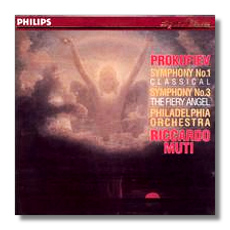
The Internet's Premier Classical Music Source
Related Links
- Prokofieff Reviews
- Latest Reviews
- More Reviews
-
By Composer
-
Collections
DVD & Blu-ray
Books
Concert Reviews
Articles/Interviews
Software
Audio
Search Amazon
Recommended Links
Site News
 CD Review
CD Review
Serge Prokofieff

Symphonies
- Symphony #1 in D Major "Classical", Op. 25 (1917)
- Symphony #3 "Fiery Angel" in C minor, Op. 44 (1928)
Philadelphia Orchestra/Ricardo Muti
Philips 432992-2 DDD 49:01
Prokofieff failed to meet the contract deadline for completing the score of his opera, The Fiery Angel, for the 1927-28 season of the Städtische Oper in Berlin, thus extending a series of failed attempts to get the work to the stage. One further effort with the Met a few years later proved futile, the negotiations never really getting off the ground. After attending a concert performance in Paris of the opera's second act given by Serge Koussevitzky in June of 1928, however, Prokofieff decided much of the music would adapt well to the symphonic form. So, he set about to rework the material, further prompted by a sense the opera was doomed never to be performed. The result of his effort was the creation of a powerfully melodramatic, evocatively theatrical symphony, his third. (The opera, it should be noted, was given a concert performance in 1954, a year after the composer's death. It reached the stage a year later and is today in the repertory of numerous companies throughout the world.)
The music in Prokofieff's Symphony #3 variously depicts the crazed obsession of Renata (the opera's main character) with the Fiery Angel (first movement), the solace of the convent (the second), and darker elements of witchcraft and devil possession (the third and fourth). But you don't have to know the opera to love this symphony. In fact, it might be better to know the symphony first before hearing the opera, because the latter is more complex and a bit more dissonant, hardly the kind of piece you'll like at first or second hearing. But don't take that to mean the music in the symphony is a distillation of its parent's most inoffensive moments. The tunes are more easily grasped, to be sure, owing mostly to the absence of the often-shrieking Renata and other hysterically-inclined characters, but the pungent harmonies and pounding rhythms are still there, and the sense of eeriness and horror predominate, with no allusion to the dark humor and satire found in the opera.
With this recording of the symphony, we have for once the marriage of superb musicianship and spectacular sound reproduction. Muti and the Philadelphia Orchestra seem possessed in their execution of this score, at one with the grim subject matter from which the music was drawn. From the screaming opening notes to the diabolical closing chords of the finale, you know you're hearing a performance conducted by a man whose baton is dripping with venom. Muti has the full measure of the score. And the Philadelphians deliver utterly virtuosic playing in capturing the contrasting virtues of brazenness and silken refinement in their correct measure. Listen to the compellingly grotesque march (track 1; 10:38) that climaxes the first movement and sends the remainder of the music into a sort of mesmerizing tailspin. Or hear how the scurrying, bizarre string theme in the third movement is rendered with such nasty relish. And I doubt the evil menace in the finale has ever been performed with such…well, evil menace. And let's not overlook the thoughtful performance of the second movement, with its quiet repose, with its hints of danger lurking around the corner. The Classical Symphony, as one might expect, is performed with the same interpretive alertness and virtuosic skill. What vigor and joy we hear in this rendition!
Of the competition in the Third Symphony, Järvi/Chandos, Rostropovich/Erato, Weller/London, and Martinon/Vox, none quite match Muti, though Järvi comes close. He has a lesser orchestra and overly bright sound, but offers a thoroughly compelling vision of the score. (I have not yet heard the Ozawa/DG recording but suspect that it, like most of his Prokofieff, is excellent.)
In sum, this Muti Prokofieff disc is absolutely thrilling in performance and sound. A must for Prokofieff lovers.
Copyright © 1997, Robert Cummings
















